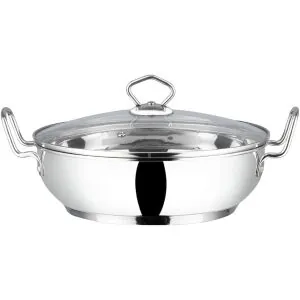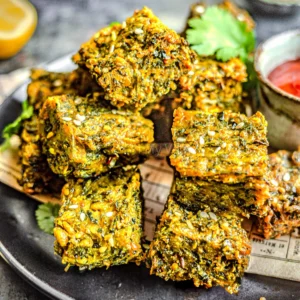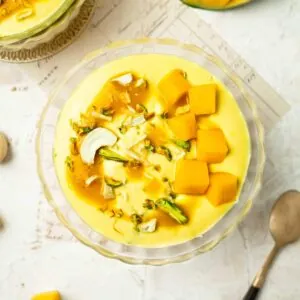Misal Pav, Maharashtrian Bean Sprout Curry
Misal pav is an iconic Maharashtrian dish made from spicy bean sprout curry topped with crunchy snacks and soaked up with fluffy bread rolls — pav. It’s a reader favourite and one of my most popular recipes for good reason!
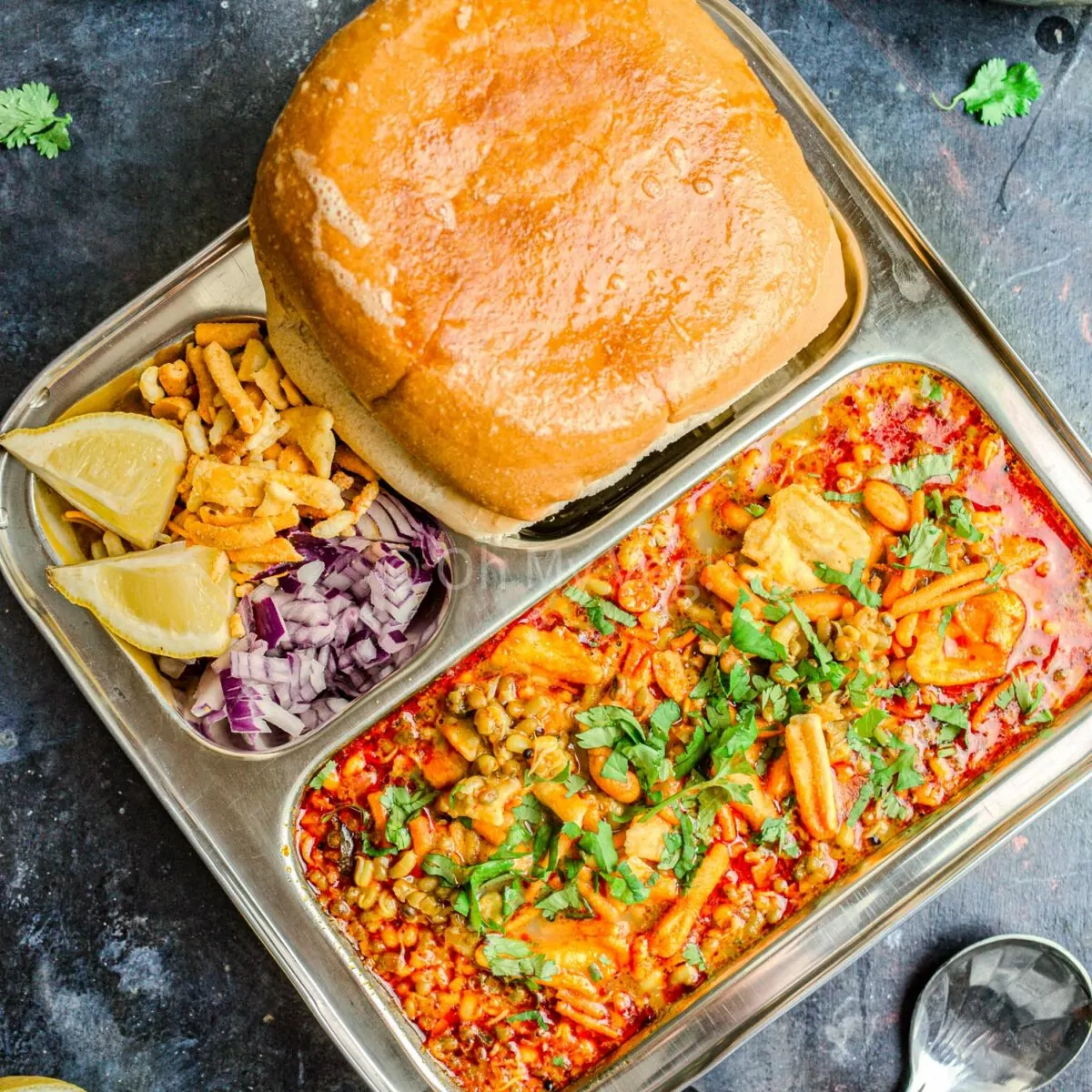
It’s almost impossible for me to pick my favourite Indian recipe, but if I had to, there’s really only one contender: misal pav. This Maharashtrian dish is everything I love about Indian food — punchy spice layered with tangy, citrusy flavour notes, earthy spices, and hints of subtle sweetness. It’s so moreish I have to stop myself from eating … and eating … and eating!
But, what is misal pav? Originating in Maharashtra, this Marathi recipe is iconic and beloved by millions nationwide. Misal is a wholesome and versatile dish made from crunchy sprouted beans cooked in a sauce enriched with aromatic roasted coconut, lemony curry leaves, sweet onions, tangy tomatoes, and layers upon layers of complex spicing. The dish isn’t complete without soft and fluffy bread rolls known as pav, also essential for other infamous Maharashtrian street foods like pav bhaji, and vada pav. The buttery bread helps soak up the vibrant, fiery curry in a way that a naan can’t quite replicate. After all, as they say, there’s no misal without pav!
Unfortunately, it’s almost impossible to find this iconic fare outside India — but don’t worry, this recipe is aeons better than anything you’d eat in a restaurant. Trust me, it’s my favourite for a reason!
Okay, let’s dive in and cover some cooking tips, variations, and, of course, the recipe!
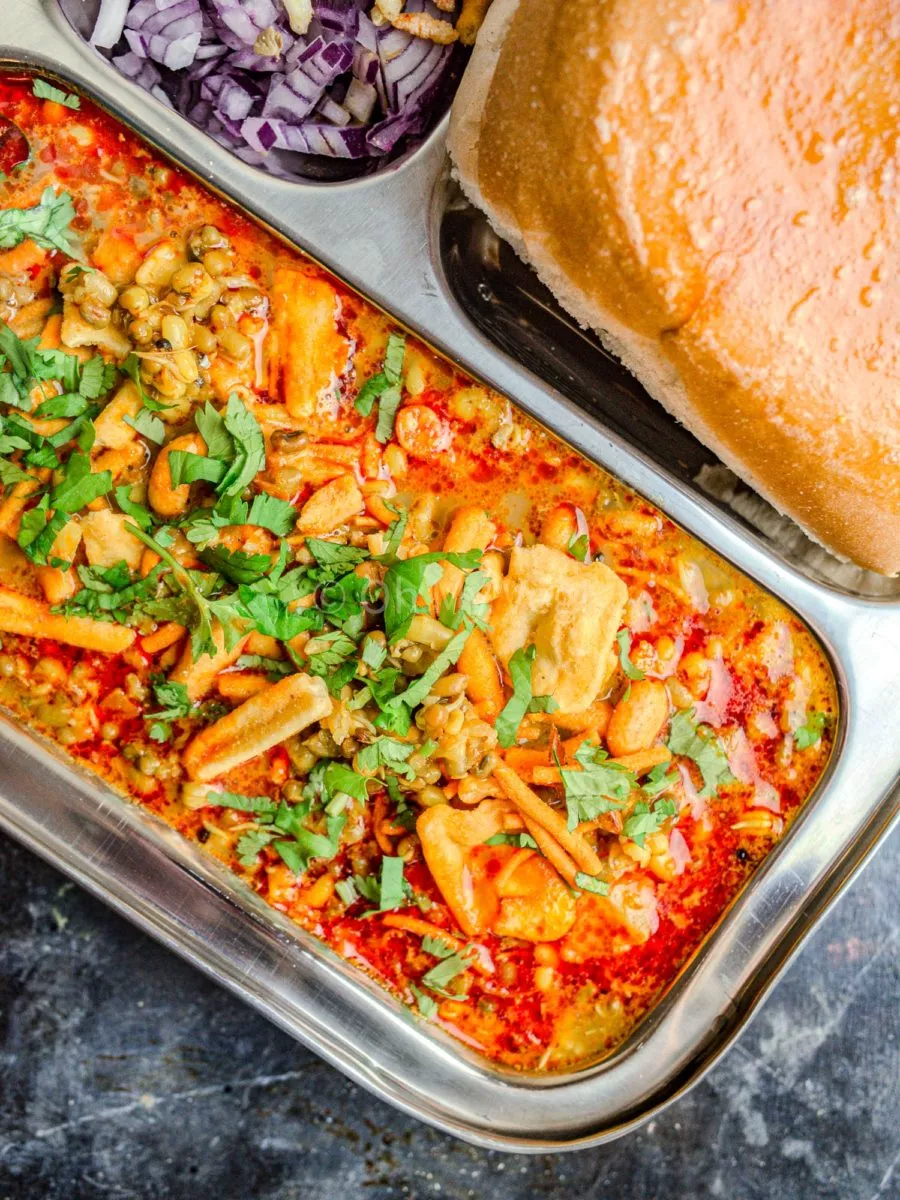
What is Misal Pav?
Misal pav is essentially a bean sprout curry.
However, unlike the beansprouts you use in Chinese recipes, these are made from moth beans alongside moong beans. We usually grow the bean sprouts at home as they aren’t sold locally. These sprouts are cooked in a rich, unctuous, spicy gravy packed with different ingredients, and the whole thing is paired with soft, buttery bread rolls known as pav.
Misal pav is an immensely popular Indian street food dish. It hails from Maharashtra, and is in great company — dahi puri chat bombs and ragda pattice are other such dishes.
What is the Difference Between Misal Pav and Usal Pav?
You might wonder: What’s the difference between misal pav, the famous Mumbai street food, and matki usal, a popular Maharashtrian breakfast?
Well, while misal pav boasts a thin, spicy gravy packed with ingredients, in comparison, usal is more homely. Usal is usually made dry (with no sauce) and is much milder in flavour. It can be made with bean sprouts, but popular variations like vatana (white pea) and chawali usal (black beans) are just as widespread. This recipe, on the other hand, is only made with bean sprouts.
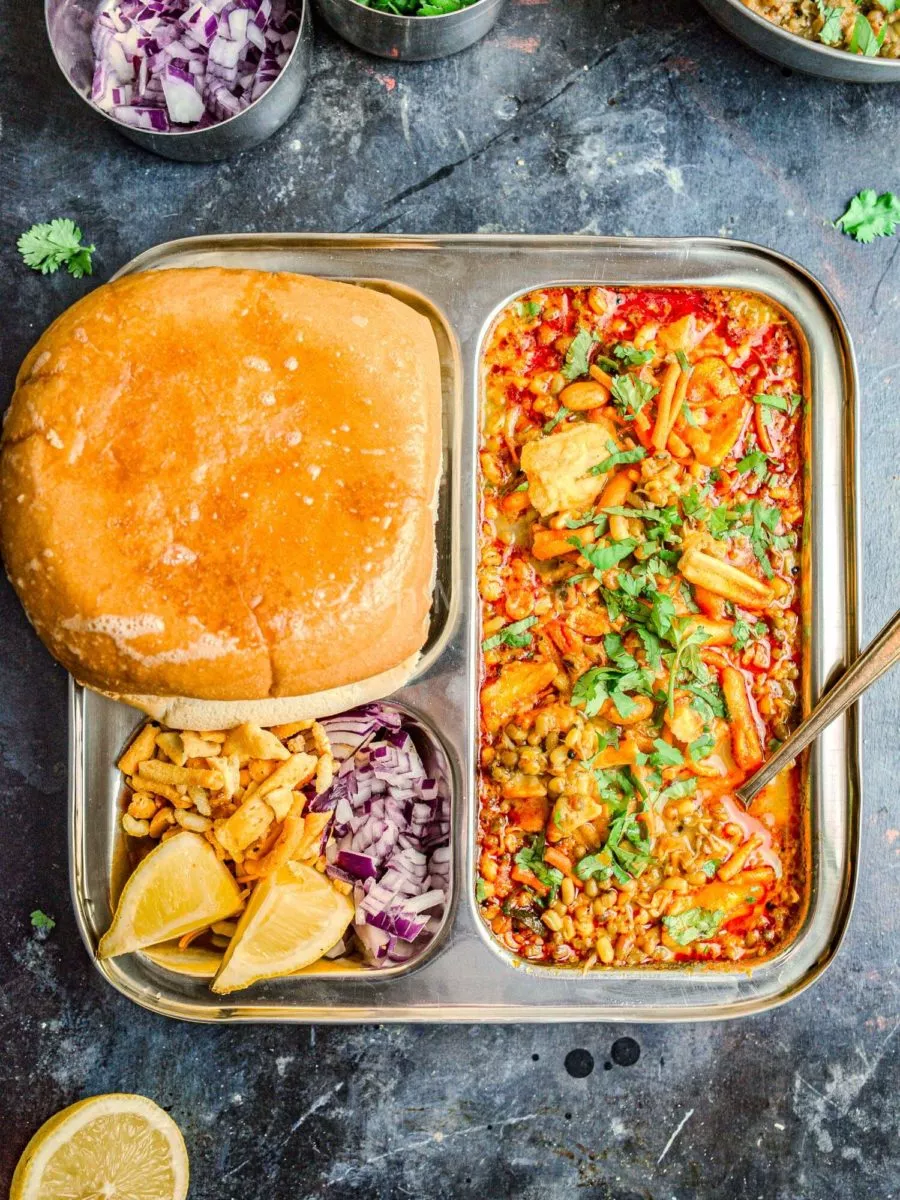
When was Misal Pav Invented?
Mysteriously, this recipe has an uncertain history, and nobody can agree when the dish first became a mainstay in Maharashtrian kitchens. Some people claim it has a history dating back to the 17th century, but one thing is for sure — there are restaurants in Maharashtra serving the dish for over a hundred years, so it’s at least that old.
The dish likely evolved from a similar dish, usal. Like many Marathi street foods, such as vada pav and pav bhaji, it was likely created as a nourishing and robust lunch for workers, then over time became a fixture of Maharashtrian cuisine.
Who Invented Misal Pav
Nobody knows who invented this iconic Marathi recipe. Many restaurants lay claim to being the “original,” but this culinary fact has likely been lost to time!
Where is Misal Pav From
Misal pav has its roots in Maharashtra, India, particularly in the western region. Its exact birthplace remains a subject of debate: some sources attribute its creation to the Khandeshi border or the city of Nashik, while others insist Pune was the first to conceive the famous dish.
Regardless, each major city of Maharashtra has a unique way of preparing the legendary dish. For example:
- Kolhapuri misal isn’t made with goda masala. Instead, it uses a distinctive blend of dried nuts and spices called kolhapuri masala, which offers a sweet, smoky, and earthy taste. You can enjoy it with pav or simple white bread, and it often comes garnished with grated coconut.
- Puneri misal pav is perhaps the most common variety, with the classic balance of spicy, sweet, and sour seasoning. It’s usually less fiery than other types.
- Nagpuri misal pav from east Maharashtra is typically spicy, as per the tastes of the Vidarbha region. Sometimes, local cooks mix kande pohe into layers of sprouts and gravy.
- Nashik misal is typically darker in colour than other types, with an unusual peppery heat. Uniquely, people generally serve the dish with fried papad (poppadoms).
- Khandeshi misal is fiery hot and boasts a bright red tarri gravy. Unlike other local varieties, khandeshi misal involves a burnt black masala (kala masala), made by whole roasting dried coconut and onions, which infuses a tantalizing smoky aroma to the plate.
I blend the best parts from various regional variations in this easy misal pav recipe, creating a simple yet delicious meal packed with authentic, intricate flavours. I can’t wait for you to try it!
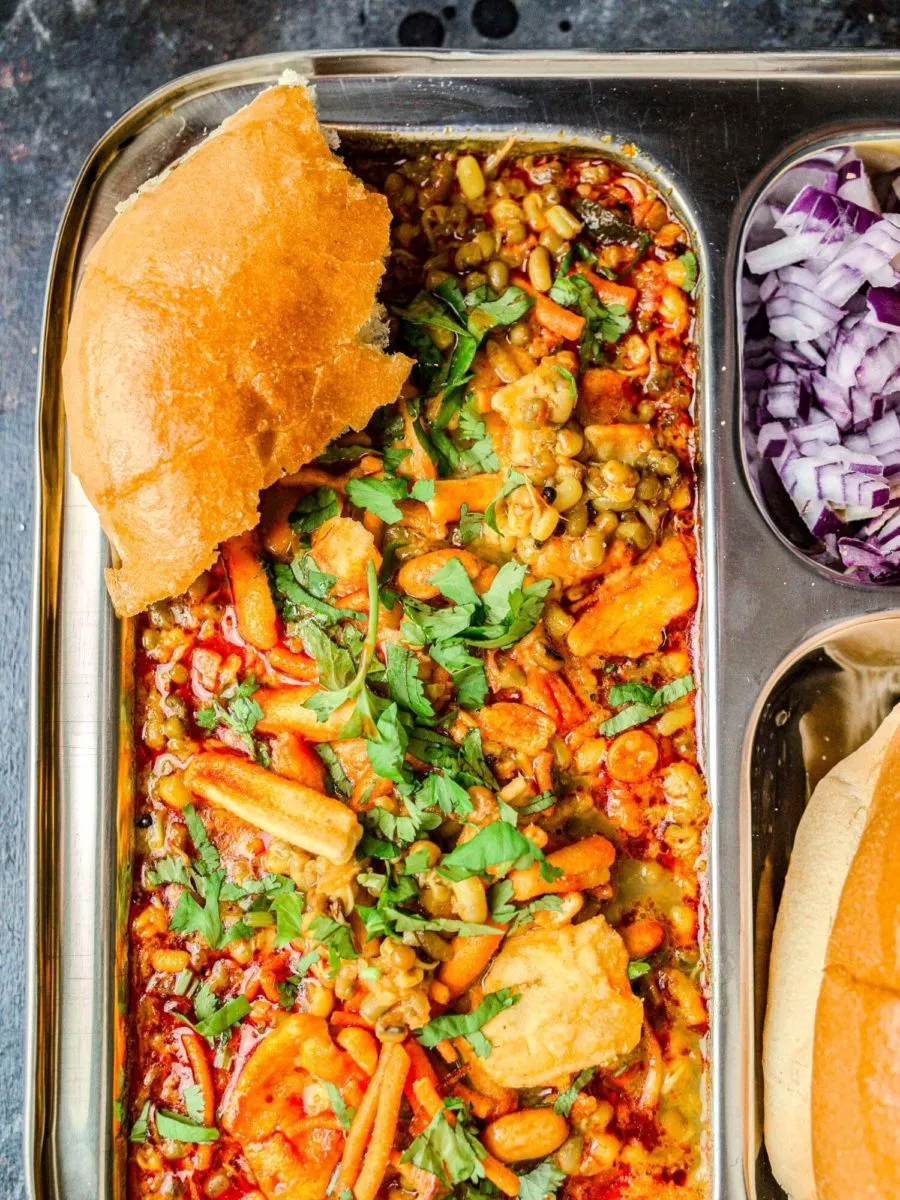
Misal Pav Ingredients
Though the list of ingredients might seem overwhelming, every element plays a crucial role in crafting the impressive and irresistibly flavorful layers found in street-style misal. Scroll down to the recipe card for complete ingredient quantities and cooking instructions.
- Moth bean sprouts, called matki in Marathi, are sprouted legumes with a slightly crunchy texture and a beautifully sweet, nutty flavour. They form the basis of this recipe.
- Moong bean sprouts are optional, but I like using two varieties of sprouts. They are earthier and creamier than moth beansprouts.
- Potatoes are another optional addition to this Maharashtrian misal pav, but they bulk up the meal nicely.
- Red onion is made into a paste, adding thickness to the misal curry and providing a gentle sweetness.
- Tomato is blended into a paste, adding subtle tangy and sour notes to the dish.
- Dry coconut is dry-roasted, providing a tempting aroma to the curry, building on the sweet and nutty elements.
- Oil is a flavour carrier and an essential element of the “tari” (or the spicy, oily layer).
- Mustard seeds add punchy heat.
- Cumin seeds complement the warm, earthy flavour notes of the bean sprouts.
- Curry leaves add a fresh, citrusy taste that is essential for hotel-style misal pav. Don’t skip this ingredient!
- Ginger-garlic paste provides a gentle creaminess and slight punchiness. I love using homemade ginger-garlic paste for the best results.
- Spice powders like red chilli, coriander, and turmeric each deliver their unique savoury profiles, building complex layers of flavour.
- Lemon juice balances out misal pav’s intensely spicy characteristic taste and adds a distinctive acidity.
- Goda masala is a traditional Marathi spice blend that is equal parts sweet and spicy. The complex flavours it delivers are unmissable; it’s a must-have, but if you don’t have access to it, swap it out for garam masala.
- Fresh coriander finishes the plate with a burst of bright freshness.
Is This Recipe Vegan, Gluten-Free, Nut-Free, and Soy-Free?
This meal is suitable for most people with food intolerances or dietary requirements! Specifically, it’s vegetarian, nut-free, and soy-free, which makes it an ideal meal for dinner parties and big gatherings. I love sharing a massive pot of misal!
Misal is inherently vegan and gluten-free, whereas the accompanying pav (bread rolls) typically aren’t. However, bear in mind that gluten-free and vegan bread rolls should be readily available to buy. Alternatively, you can pair misal with any bread of your preference.
To make misal pav without onion and garlic, skip the ginger-garlic paste in this recipe. With one tiny adaptation, you have an easy Jain misal pav recipe.
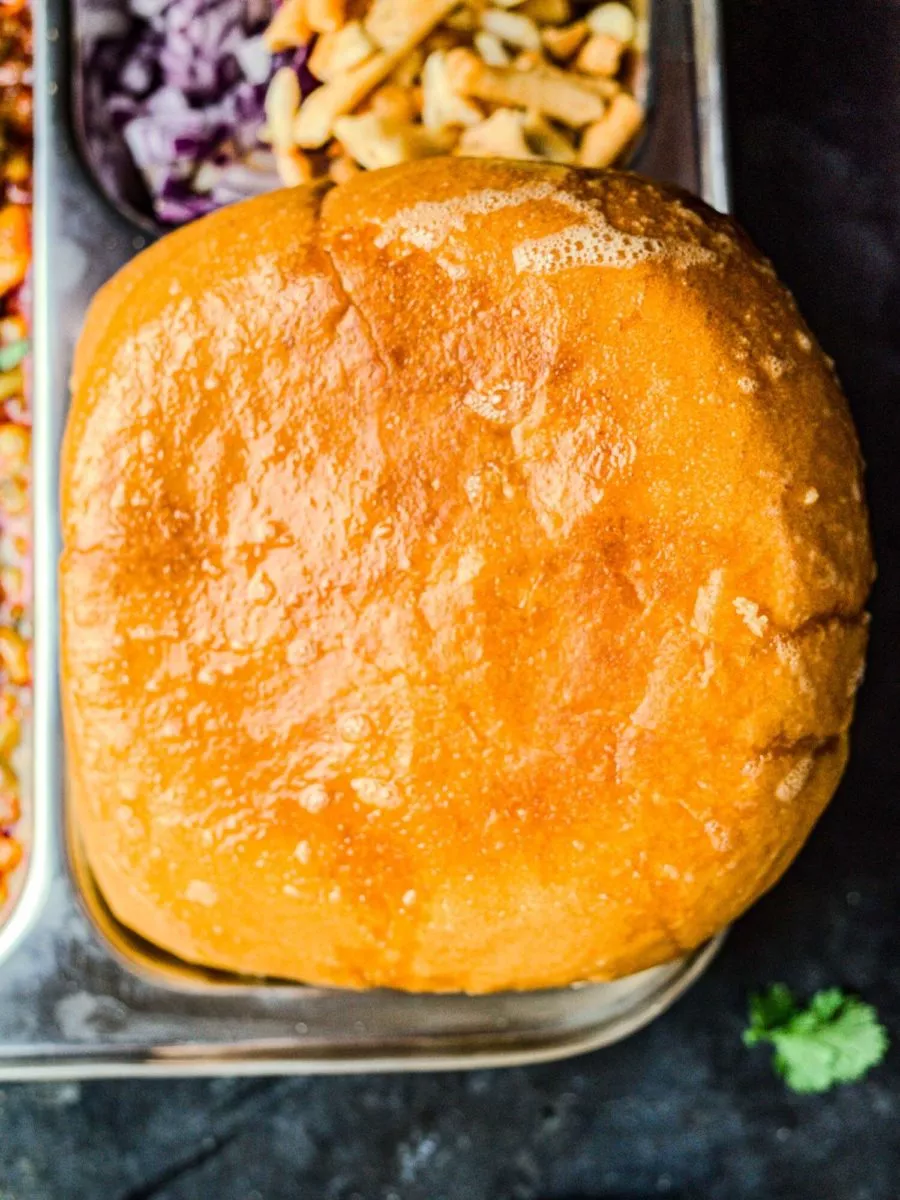
How to Make Misal Pav
Here’s an overview of “misal pav banane ki vidhi,” or the process of making this Maharashtrian dish! For detailed instructions and ingredient quantities, please scroll down to the recipe card.
- Sprout the beans over a few days,
- Cook the bean sprouts and potato with turmeric powder until softened.
- Make a paste of roasted dry coconut, tomato, and onions.
- Cook the tarri/kat by frying off the whole spices, curry leaves, homemade ginger-garlic paste, the prepared tomato-onion-coconut paste, and ground spices until the oil separates.
- Cook the misal by adding the bean sprouts, potatoes, and water to the pan and simmer gently until the spicy oil (kat) rises to the top.
- Layer the misal with farsan (crispy mixture), kanda poha (optional), plus finely chopped onion, tomato, and coriander.
- Heat the pav in butter. I prefer my pav gloriously crispy on top with a soft inside, but alternatively, you can heat the bread through without crisping if you wish.
What to Serve with this Recipe
What do you eat with misal? At a minimum, this legendary food is always served with extra wedges of lemon, chopped onion, coriander, and tomato to add to your plate to taste, crunchy farsan/chivda, and buttery pav. You can buy specialist misal pav farsan expressly for the dish or use your favourite mixture.
Some restaurants and street-side vendors also offer a plate of kat/tari/rassa alongside the serving plate — essentially the thin, spicy, oily layer of the gravy. You can then add it to your curry to increase the spice. If you want to recreate this at home, carefully spoon off the top layer of the misal before serving and add it to a separate bowl.
Here are some more scrumptious serving ideas:
- Misal pav and sabudana vada is a common combination in Mumbai and makes for an exceptionally hearty breakfast or lunch. If you want to give it a go, follow my upvas special sabudana vada recipe alongside this one!
- Misal with pohe is the go-to option for many in eastern Maharashtra, and for good reason. Check out my kanda poha recipe and add a layer of the flattened rice under the misal.
- Misal pav with dahi/yoghurt is my first recommendation for anyone with a low spice tolerance. It cools the fiery nature of the misal tarri.
- Misal pav with papad adds a nice crunchy texture to the plate. Fry or microwave any urad dal poppadoms and serve alongside.
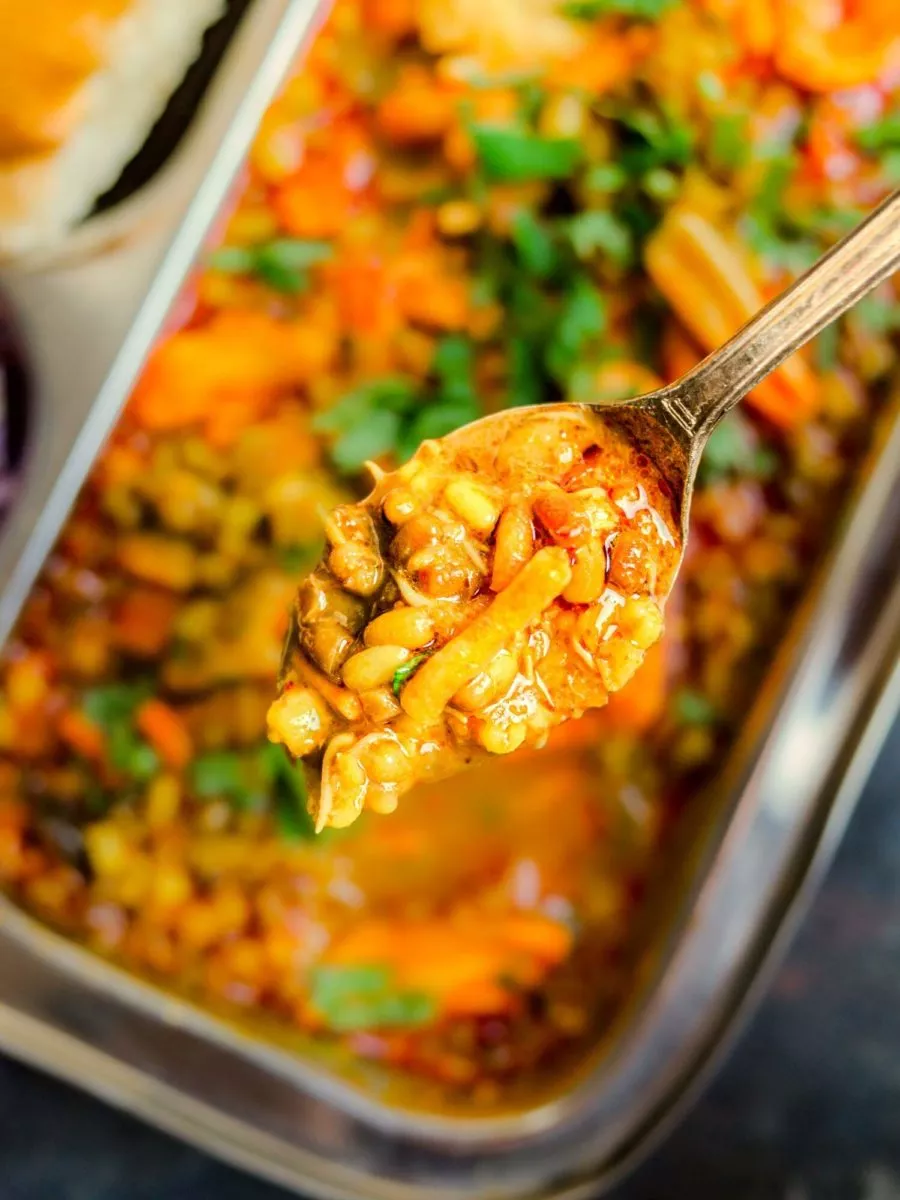
Is Misal Pav Healthy?
Perhaps surprisingly, Maharashtrian misal pav is rich in many essential nutrients. For example, sprouted moth and moong beans are high in protein and offer copious amounts of healthy fibres, folates, and iron, amongst other vital vitamins. That’s not to mention the spices, which have numerous health benefits!
However, this dish is notoriously heavy on oil — a vital component of the “tarri” or “kat,” the vibrant red spicy oil formed on top of the dish. To make your food healthier, you should decrease the oil used, but you may forgo that classic street-style taste.
Is Misal Pav Spicy?
Yes! Misal pav is notoriously spicy, and trying the dish is a requisite for anyone who loves fiery, piquant foods.
However, spice levels of the dish vary across Maharashtra, not to mention certain restaurants and families will make the dish with varying levels of chilli. Not all interpretations of the dish are mind-numbing spicy!
In fact, this recipe is perfectly seasoned. With three teaspoons of chilli powder, it’s got a kick — this makes it not quite as hot as some Indian joints, but ideally spiced for the average reader. Furthermore, if you’re not used to eating spicy food, you can adjust the chilli levels and slowly build it up. Alternatively, you can add more!
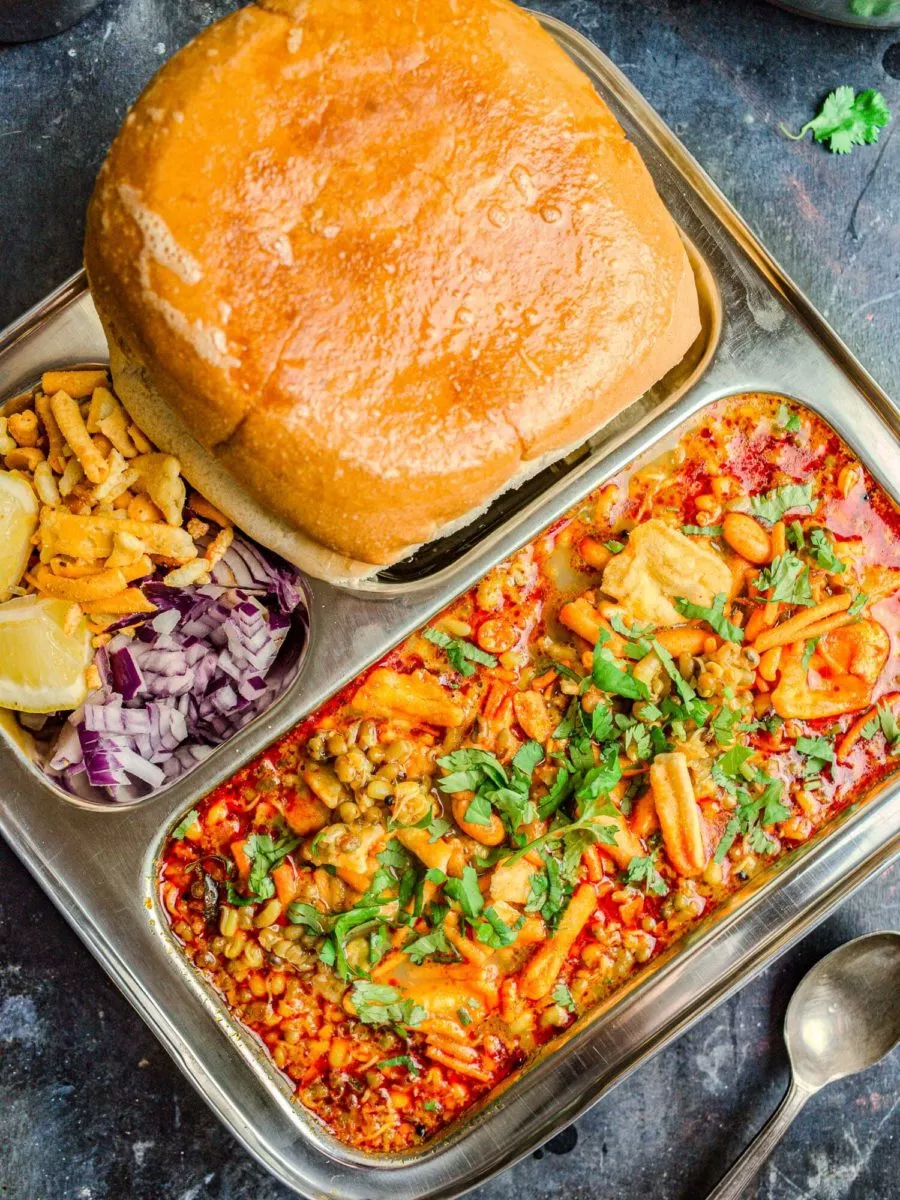
This Recipe Is …
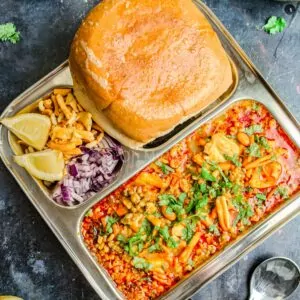
Misal Pav Recipe
Ingredients
To Cook the Sprouts:
- 120 g moong and moth bean sprouts*
- 80 g potato cubed, optional
- ½ teaspoon turmeric powder
- 550 ml water
To make a Paste:
- 2 tablespoons desiccated coconut or dry coconut
- 60 g red onion roughly chopped
- 100 g tomatoes roughly chopped
For the Curry:
- 2 ½ tablespoons neutral oil**
- ½ teaspoon black mustard seeds
- 1 teaspoon cumin seeds
- 6 fresh curry leaves
- 2 teaspoon ginger garlic paste
- 1 ½ teaspoon red chilli powder
- 1 ½ teaspoon deggi mirch or Kashmiri chilli powder
- ½ teaspoon coriander powder
- 1 teaspoon sea salt ground, or to taste
- 100 ml water
- 1 teaspoon lemon juice
- 2 teaspoon goda masala or use 1 teaspoon garam masala
To Serve
- red onion finely chopped, to taste
- fresh tomato finely chopped, totaste
- farsan/chivda to taste
- fresh coriander cilantro in the U.S., finely chopped, to taste
- 8 vegan pav white bread rolls, buttered and heated
Instructions
- Cook 120 g moong and moth bean sprouts* and 80 g potato with ½ teaspoon turmeric powder until softened. Pressure cook for 2 whistles or boil in a deep saucepan for around 20 minutes.
- Dry roast 2 tablespoons desiccated coconut on a tawa or frying pan until it's golden and aromatic. Cool the coconut, then blend it with 100 g tomatoes and 60 g red onion to make a paste. Set aside.
- Heat 2 ½ tablespoons neutral oil** in a large kadai and once hot, add ½ teaspoon black mustard seeds and 1 teaspoon cumin seeds. Once they pop, add 6 fresh curry leaves (be careful, as they may spit), and sauté for around 30 seconds, then add the prepared tomato-onion-coconut paste and 2 teaspoon ginger garlic paste. Sauté until the raw smell fades, then add the ground spices (1 ½ teaspoon red chilli powder, 1 ½ teaspoon deggi mirch, ½ teaspoon coriander powder, and 1 teaspoon sea salt). Cook, stirring consistently, until the oil separates.
- Add the beansprouts, potatoes, their cooking water, and an additional 100 ml water to the kadai/pan. Bring to a gentle simmer and cook until the tarri/kat (spicy oil) rises to the top. At this stage, season with 1 teaspoon lemon juice and 2 teaspoon goda masala. Turn off the heat.
- Layer the misal by adding farsan/chivda (crispy mixture) on top, plus finely chopped red onion, fresh tomato, and fresh coriander to taste. You can also add kande pohe (optional).
- Heat 8 vegan pav in butter (non-dairy to keep the recipe vegan). Slice them in half and fry gently in butter over low heat. If you want them slightly crispy, press on the bread. Serve alongside the misal.
- Serve the misal with extra lemon wedges, chopped onion, tomato, coriander, and farsan for people to add to their plates as they desire.


